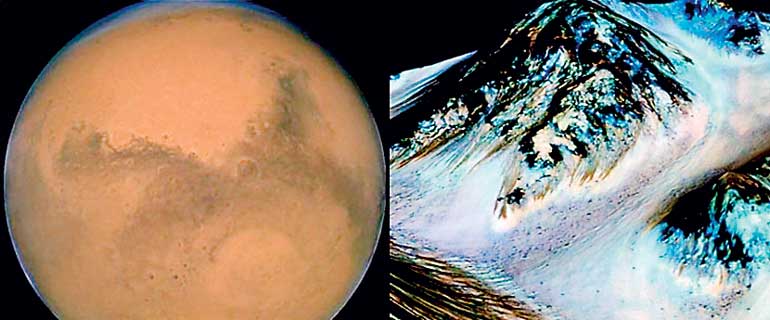Tuesday Dec 23, 2025
Tuesday Dec 23, 2025
Wednesday, 30 September 2015 00:00 - - {{hitsCtrl.values.hits}}

Briny water flows during the summer months on Mars, raising the possibility that the planet long thought to be arid could support life today, scientists analysing data from a NASA spacecraft said on Monday.
Although the source and the chemistry of the water is unknown, the discovery will change scientists’ thinking about whether the planet that is most like Earth in the solar system hosts microbial life beneath its radiation-blasted crust.
“It suggests that it would be possible for life to be on Mars today,” John Grunsfeld, NASA’s associate administrator for science, told reporters, discussing the study published in the journal Nature Geoscience.
“Mars is not the dry, arid planet that we thought of in the past. Under certain circumstances, liquid water has been found on Mars,” said Jim Green, the agency’s director of planetary science.
But NASA will not be rushing out to search the newly discovered saltwater residue for life just yet. “If I were a microbe on Mars, I would probably not live near one of these (sites). I would want to live further north or south, quite far under the surface and where there’s more of a freshwater glacier. We only suspect those places exist and we have some scientific evidence that they do,” Grunsfeld said.
The discovery of the water flows was made when scientists developed a new technique to analyse chemical maps of the surface of Mars obtained by NASA’s Mars Reconnaissance Orbiter spacecraft.
They found telltale fingerprints of salts that form only in the presence of water in narrow channels cut into cliff walls throughout the planet’s equatorial region.
The slopes, first reported in 2011, appear during the warm summer months on Mars, then vanish when the temperatures drop. The chemical fingerprints of hydrated minerals did likewise, the new study showed.
Scientists suspected the streaks, known as recurring slope lineae, or RSL, were cut by flowing water, but previously had been unable to make the measurements.